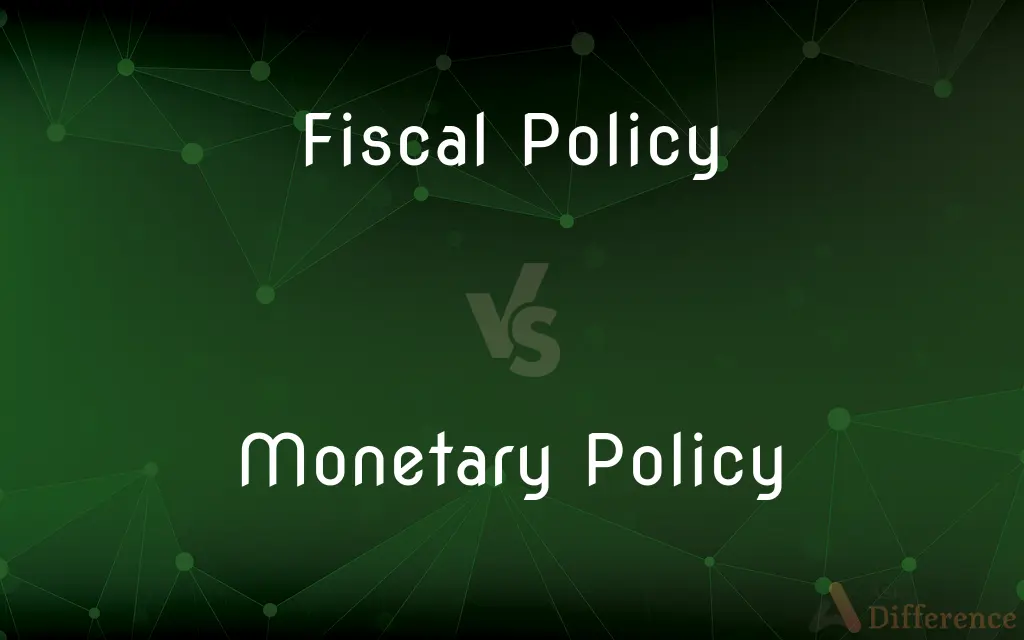Fiscal Policy vs. Monetary Policy — What's the Difference?
By Tayyaba Rehman — Published on October 27, 2023
Fiscal Policy involves government spending and taxation to influence the economy, while Monetary Policy uses money supply and interest rates to regulate economic activity.

Difference Between Fiscal Policy and Monetary Policy
Table of Contents
ADVERTISEMENT
Key Differences
Fiscal Policy pertains to how governments adjust their spending levels and tax rates to impact the economy. These changes can either stimulate a slowing economy or cool down an overheated one. Monetary Policy, on the other hand, is the approach central banks take to manage the amount of money circulating in an economy and the prevailing interest rates.
Fiscal Policy directly affects government finances. A government might increase spending in public projects to stimulate growth or reduce tax rates to increase disposable income. In contrast, Monetary Policy involves tools like changing the reserve requirements for banks, conducting open market operations, and adjusting the discount rate to impact the availability and cost of money in an economy.
One crucial distinction is the entity responsible for each policy. Fiscal Policy is usually decided by the national government or legislature. In the U.S., for instance, fiscal decisions are made by Congress and the Executive Branch. Monetary Policy, conversely, is typically the realm of the central bank, like the Federal Reserve in the U.S.
While both Fiscal Policy and Monetary Policy aim to achieve stable economic growth and low unemployment, they function via different mechanisms. Fiscal Policy depends on influencing aggregate demand through government expenditure and taxation. Monetary Policy, meanwhile, seeks to influence the money supply and interest rates, affecting borrowing, lending, and overall financial conditions in the economy.
Comparison Chart
Definition
Government's tax and spending decisions.
Central bank's management of money supply and interest rates.
ADVERTISEMENT
Tools Used
Government spending, taxation.
Open market operations, discount rate, reserve requirements.
Responsible Entity
National government or legislature.
Central bank (e.g., Federal Reserve in the U.S.).
Primary Objective
Influence aggregate demand.
Manage inflation and stabilize the financial system.
Time Lag for Effect
Often longer due to legislative process.
Can be quicker, depending on the tool used.
Compare with Definitions
Fiscal Policy
Measures impacting a country's economic direction via public finance.
Analysts debated the long-term impact of the new Fiscal Policy on growth.
Monetary Policy
Strategies influencing financial conditions in the economy.
Due to inflation concerns, a more restrictive Monetary Policy was adopted.
Fiscal Policy
The government's approach to taxation and spending.
The government adopted an expansionary Fiscal Policy to combat the recession.
Monetary Policy
Measures to stabilize or stimulate an economy via money controls.
The dovish stance on Monetary Policy boosted stock market sentiment.
Fiscal Policy
Strategy for managing government revenue and expenditures.
Fiscal Policy decisions in the budget affected the nation's deficit.
Monetary Policy
Central bank's tools for controlling the money supply.
The Federal Reserve's tightening of Monetary Policy led to higher interest rates.
Fiscal Policy
Framework guiding a nation's financial decisions.
The country's Fiscal Policy emphasized infrastructure development.
Monetary Policy
Management of interest rates and liquidity by a central bank.
Experts speculated on the next move in Monetary Policy amidst economic uncertainty.
Fiscal Policy
Government actions altering macroeconomic conditions through budgetary measures.
To reduce unemployment, the administration modified its Fiscal Policy.
Monetary Policy
Actions adjusting the cost and availability of money.
After the financial crisis, an accommodative Monetary Policy was deemed necessary.
Common Curiosities
Who manages Fiscal Policy?
Fiscal Policy is managed by the national government or legislature.
What is the primary tool of Monetary Policy?
Monetary Policy primarily uses tools like money supply control and interest rate adjustments.
How does Monetary Policy combat inflation?
Monetary Policy combats inflation by reducing the money supply or raising interest rates, making borrowing more expensive.
Can Fiscal Policy lead to higher deficits?
Yes, if a government increases spending or decreases taxes without corresponding changes, it can lead to higher deficits.
How does Fiscal Policy affect economic growth?
Fiscal Policy influences growth by adjusting government spending and taxation, impacting aggregate demand.
What's an expansionary Fiscal Policy?
An expansionary Fiscal Policy involves increasing government spending or decreasing taxes to stimulate the economy.
Can Fiscal Policy address income inequality?
Yes, Fiscal Policy can use progressive taxation or targeted spending to address income disparities.
How do interest rates factor into Monetary Policy?
Interest rates are a key tool in Monetary Policy, influencing borrowing, lending, and overall economic activity.
How does Monetary Policy affect unemployment?
Indirectly. By influencing economic conditions, Monetary Policy can impact the level of hiring and unemployment.
What role does the central bank play in Monetary Policy?
The central bank designs and implements Monetary Policy, influencing the money supply and interest rates.
How does Monetary Policy impact exchange rates?
Interest rates, influenced by Monetary Policy, can attract or repel foreign capital, impacting exchange rates.
Why is Monetary Policy essential for financial stability?
Monetary Policy helps stabilize prices, manage inflation, and ensure a stable financial system.
Are Fiscal Policy and Monetary Policy always in sync?
Not necessarily. While both aim for economic stability, they might sometimes have conflicting short-term goals.
Does Fiscal Policy have immediate effects on the economy?
Fiscal Policy often has a longer time lag due to the legislative process and the time it takes for spending to occur.
Can Fiscal Policy address recessions?
Yes, an expansionary Fiscal Policy can stimulate demand and potentially help counteract recessions.
Share Your Discovery

Previous Comparison
Salad Cream vs. Mayonnaise
Next Comparison
Belgian Malinois vs. Belgian ShepherdAuthor Spotlight
Written by
Tayyaba RehmanTayyaba Rehman is a distinguished writer, currently serving as a primary contributor to askdifference.com. As a researcher in semantics and etymology, Tayyaba's passion for the complexity of languages and their distinctions has found a perfect home on the platform. Tayyaba delves into the intricacies of language, distinguishing between commonly confused words and phrases, thereby providing clarity for readers worldwide.
















































